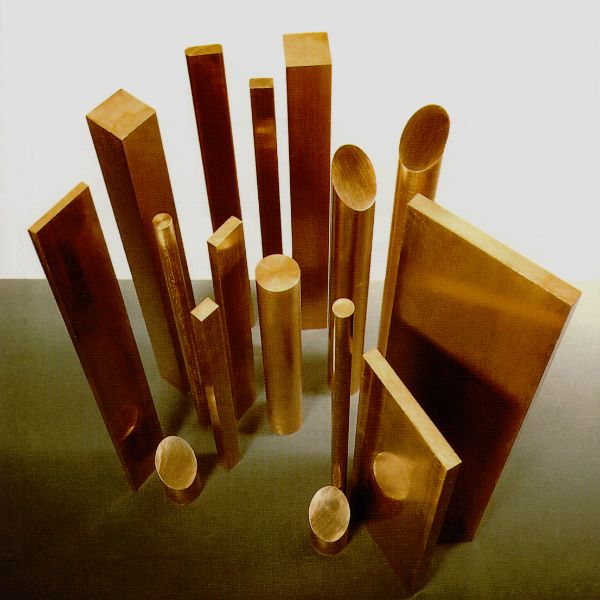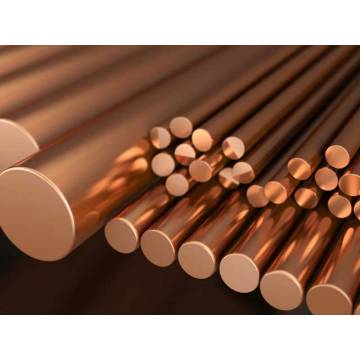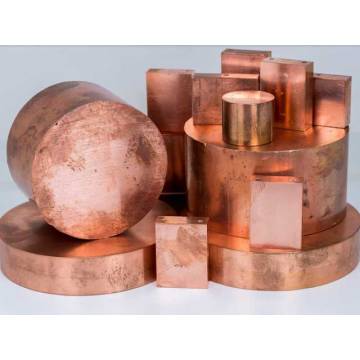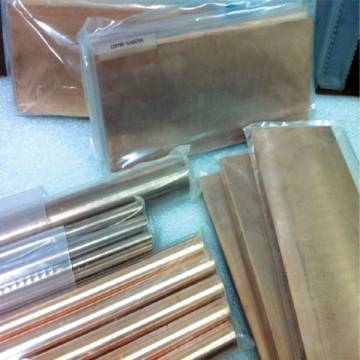Copper
Oxygen Free Copper (OFHC)
Specifications
- JIS C1011
- ASTM C10100
- ISO Cu-OF
Summary
- For industrial applications, oxygen-free copper is valued more for its chemical purity than its electrical conductivity.
- Oxygen-Free copper, abbreviated OFC (or OFHC) is a grade of copper free of oxygen, containing no deoxidants. It is distinguished by its high degree of purity compared to other available grades of copper. The content of permissible impurities is limited to only a maximum of 74ppm. (1ppm = 0.0001%)
- This is the purest form of copper available in the market, containing up to a minimum of 99.99% purity. The OFC is removed of oxygen and manufactured from electrolytic copper, and can be considered a top grade copper in terms of electrical conductivity.
- OFC is used in applications such as plasma deposition (sputtering) processes, the manufacture of semiconductors, and accelerators. In any of these applications, the release of oxygen or other impurities can cause undesirable chemical reactions with the materials in the local environment.
Introduction:
Oxygen-Free High Conductivity Copper (OFHC) is a type of high-purity copper renowned for its exceptional electrical conductivity and thermal properties. It is widely utilized in various industries, including electronics, power transmission, telecommunications, and aerospace. OFHC copper is particularly valued for applications demanding minimal electrical resistance and superior thermal management capabilities. Understanding its properties, applications, and manufacturing processes is crucial for engineers and manufacturers aiming for optimal performance in high-current applications.
Properties of OFHC Copper:
- High Electrical Conductivity: OFHC copper exhibits an electrical conductivity of over 100% IACS (International Annealed Copper Standard), making it one of the most conductive metals available. This property ensures efficient transmission of electrical signals and minimal power loss.
- Low Oxygen Content: OFHC copper is produced through a specialized manufacturing process that reduces the oxygen content to below 10 parts per million (ppm). Low oxygen levels enhance the material's conductivity and prevent the formation of oxide layers, ensuring high reliability in electrical connections.
- Excellent Thermal Conductivity: OFHC copper possesses outstanding thermal conductivity, allowing for effective heat dissipation in electronic components and power transmission systems. This property helps in maintaining optimal operating temperatures and prolonging the lifespan of equipment.
- Ductility and Formability: OFHC copper is highly ductile and malleable, enabling it to be easily formed into various shapes and sizes through processes such as extrusion, drawing, and forging. This versatility facilitates the production of complex components tailored to specific application requirements.
- Corrosion Resistance: While OFHC copper is not immune to corrosion, its high purity and low oxygen content make it more resistant to tarnishing and corrosion compared to standard copper alloys. This characteristic ensures long-term reliability, particularly in environments prone to moisture and oxidation.
Applications of OFHC Copper:
- Electronics and Telecommunications: OFHC copper is widely used in the manufacturing of electrical connectors, printed circuit boards (PCBs), RF (radio frequency) components, and high-frequency transmission lines due to its excellent conductivity and signal integrity.
- Power Transmission and Distribution: OFHC copper is employed in power generation, distribution, and transmission systems, including high-voltage cables, busbars, transformers, and switchgear components. Its low resistance minimizes energy losses and ensures efficient power transfer.
- Aerospace and Defense: OFHC copper is utilized in aerospace applications, such as satellite components, avionics systems, and radar equipment, where high reliability, lightweight construction, and superior electrical performance are essential.
- Medical Devices: OFHC copper finds application in medical devices and equipment, including MRI (magnetic resonance imaging) machines, X-ray detectors, and surgical instruments, where its biocompatibility, conductivity, and sterilizability are advantageous.
Manufacturing Process:
The production of OFHC copper involves several stages, including:
- Copper Refining: High-purity copper is obtained through electrolytic refining or other purification methods to remove impurities, including oxygen, sulfur, and other trace elements.
- Casting: The refined copper is cast into ingots or billets using various casting techniques, such as continuous casting or direct chill casting.
- Forming: The cast copper is further processed through extrusion, rolling, or drawing to produce OFHC copper wire, rods, sheets, or custom shapes with the desired dimensions and mechanical properties.
- Annealing: The formed OFHC copper is subjected to annealing processes to relieve internal stresses and optimize its electrical conductivity.
Conclusion:
OFHC copper stands out as a premium material choice for applications requiring superior electrical conductivity, thermal management, and reliability. Its remarkable properties, including high purity, low oxygen content, and excellent formability, make it indispensable in industries where high-performance materials are essential. By leveraging OFHC copper's unique characteristics, engineers and manufacturers can develop innovative solutions for a wide range of demanding applications, ensuring optimal performance and longevity.
Share






